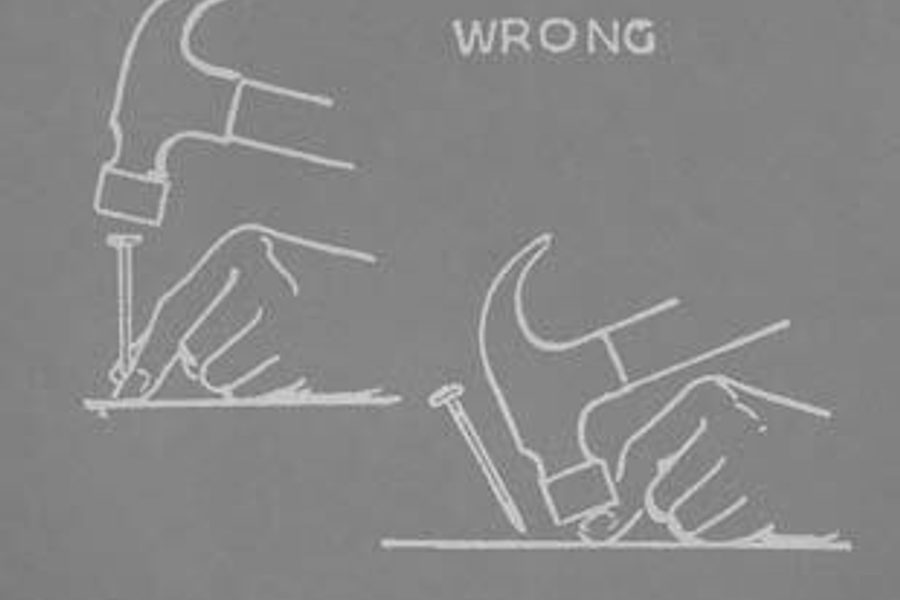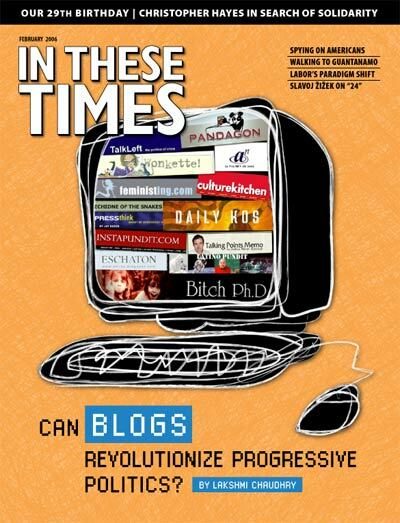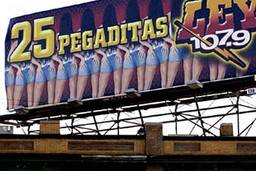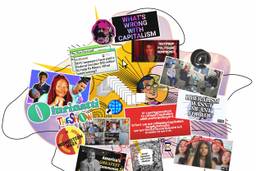
Crafts are officially cool again. At many a chain bookstore, ReadyMade magazine’s new book, ReadyMade: How to Make (Almost) Everything, isn’t tucked away in the “Crafts” section, but stacked four high on the front display table.
Hip, design-savvy and eco-friendly, the book embodies one pole of a flourishing craft movement that draws equal inspiration from politics, art and urban living. It signals the latest incarnation of the craft movement – which appears every time a new generation discovers the pleasure of handicraft (recall the ’60s back-to-the-land, Whole Earth Catalog crowd). The book joins a crop of new craft titles that draw from the best of Martha Stewart, then add a dash of your dumpster-diving, protest-attending college roommate.
ReadyMade magazine, which started publishing in 2001, released its eponymous resource book in December, just in time for the deluge of holiday shoppers simultaneously over-consumed and broke. The magazine’s title comes from surrealist Marcel Duchamp, who coined it to refer to the ordinary objects he altered or signed and then called art.
“Learn how to turn everyday objects into spellbinding inventions,” the cover blurb invites. “Our simple self-improvement techniques will make you smarter, better looking, and more well-adjusted.”
Organized by material (paper, plastic, wood, metal, glass and fabric), each section provides brief history of the substance and an overview of its manufacturing. Then come the projects, rated on a difficulty level from “monkey” to “craftsman” (who “knows that a “stud finder is not a matchmaking service!”), each with its own stylized icon. The “Remake This!” sections showcase a project they tried to make work, but which ended up more complicated than pleasing. Most cloying or endearing – depending how much the McSweeney’s crowd raises your bile – are the clever non-craft lessons: “How to Make a Film Like Ingmar Bergman,” “A Look Back at the Origins of Heavy Metal” and “How to Tell a Good Story.”
They are the most ambitious aspect of the book, arguing that the craft ethos applies to one’s entire life. They hark back to the Foxfire books (recently reissued by Anchor Books), the pioneering oral history project of the ’70s, which had Georgia high school students interview elders in their communities for histories on everything from washing laundry in an iron tub to telling ghost stories. Here though, Grandma’s been replaced by Ira Glass.
Still, there is an uneasy relationship between the rhetoric of reuse and refashion and the underlying comfort with consumption. The introduction to the paper section provides dismaying statistics about paper manufacturing, but they’re quickly bracketed with cheery reassurances: “The good news is that trees are renewable, and American farms, planting millions of seeds each year now contribute nearly 90 percent of the raw material used to make paper.” Phew! For a second there it sounded as if we should put down our crafts and organize around that.
Glossy, modernist ReadyMade sits on the design end of this new craft-resurgence, with inside cover blurbs from celeb aesthetes like Dave Eggers and Todd Oldham. But another strand of the craft movement, one that views itself as overtly political, utilizes DIY (do it yourself) as a means of subverting disposable consumption, and questions the ghettoizing of crafts as women’s work. It’s grown up in conjunction with postfeminist magazines Bitch, Bust and Venus, and has ties to various activist communities.
Greg Der Ananian’s Bazaar Bizarre: Not Your Granny’s Crafts! proudly flies its freak flag. Named for the bi-coastal craft fair run by its author, Bazaar Bizarre is a collection of how-to-make-it presentations by the fair’s artists, from sock monkeys to mini-shrines made of Altoids boxes. Der Ananian introduces each crafter with a short bio, a mug shot and brief Q&A. Clearly the edgier of the two books, the difficulty level of each craft here is given in number of anarchist symbols – one to five.
Der Ananian takes on one of the complicated questions of the craft movement, asking each crafter “What is the difference between an ‘art’ and a ‘craft’?” Many of the artists – Der Ananian’s term – argue that their work is designed to break down this distinction that pits “skills” against “functionality.” The best answer, however, belongs to Stacie Dolins: “Art goes on your wall. Art rhymes with fart; craft rhymes with daft.”
More is at work here than just a punk sensibility (though Der Ananian does have a disclaimer box to explicate the book’s use of “punk” and “punk rock.”) There’s the question of class. ReadyMade has always emanated a college-educated, streamlined, art-school vibe, while Bazaar Bizarre is solidly broke, challenge-the-establishment, rock-kid DIY. The difference is made amusingly clear in their choice of joking drug references: On the topic of office paper, ReadyMade, assures readers they are “very much in favor of the recreational use of the white stuff,” while Bazaar Bizarre cautions crafters to keep the industrial-strength glue “away from the huffers.”
This resistance to the status quo likely informs Bazaar Bizarre’s choice to confront the underlying gender roles of the craft movement. Crafts have traditionally been associated with homemakers, a stereotype Bazaar Bizarre tackles head on. One section, “Watch Where You Put That Friggan Distaff!,” concludes:
We as crafters can figuratively and literally cut the ties that bind us to the notion that crafts are quiet or weak. The predictably precious imagery of commercialized decorative crafting only fosters the lame sexist ideas surrounding traditional handicrafts and their worth in a culture that wants to keep crafts in a very specific devalued pocket of representation. I suggest we take hold of the distaff of appropriation and beat the husband of dominant aesthetics.
So which is it? Is the resurgent craft movement a new form of consumption, albeit with more felt and assembly, or is it a bold political act that challenges the way we think about gender roles and how we engage with our commodified world?
The crafters themselves seem conflicted. Daniel Tucker, an activist and editor of the Chicago “art/education/activism” magazine Area, questions whether those involved in the emergent hip-craft movement have really asked themselves what they are trying to do. “If we should buy locally made goods, what is their analysis about local economies and how they work or could work better?,” Tucker asks. “How sustainable is it for people to buy their products from hipsters?”
Even those at the center of the emerging “hip” craft fairs don’t always identify their actions as political. Cassie Allen, of the Chicago Women’s Craft Collective, says that her involvement with crafts began not as a political action, but as “creative time with other women, in a shared space.” And while she says her crafts challenge the corporate, mass-produced status quo, “Corporate culture has embraced the craft movement – the tiny Jo-Ann Fabrics near where I work just turned into a Jo-Ann megastore.” For her, some of the revolutionary nature of this resurgence was that people, especially women, were finding validation as well as markets for their crafts.
Sue Blatt, co-founder of the Renegade Craft Fair in Chicago, which just expanded to Brooklyn, echoes this idea. “We didn’t think of it as political, although I guess it could be taken that way,” Blatt says. “We just wanted to take charge, provide a venue for the emerging DIY revolution that was happening but didn’t have a place in the mainstream.”
Perhaps that’s enough. This new craft movement has fought its way into our popular culture with some of its reuse, DIY ethic intact. It’s given a new generation of crafters, many of them women, a market and a vehicle for community.
“I’m very wary of making the DIY craft movement into something bigger than it is,” says Annie Tomlin, who is herself a crafter and covers the DIY movement as an editor at Time Out Chicago. “Some people make overt political statements with their crafted work, while others just like to ‘make stuff.’ In that latter category, I don’t see a lot of room for intentional activism. Knitting an iPod cozy alone isn’t going to protect the right to an abortion.”

I hope you found this article important. Before you leave, I want to ask you to consider supporting our work with a donation. In These Times needs readers like you to help sustain our mission. We don’t depend on—or want—corporate advertising or deep-pocketed billionaires to fund our journalism. We’re supported by you, the reader, so we can focus on covering the issues that matter most to the progressive movement without fear or compromise.
Our work isn’t hidden behind a paywall because of people like you who support our journalism. We want to keep it that way. If you value the work we do and the movements we cover, please consider donating to In These Times.






